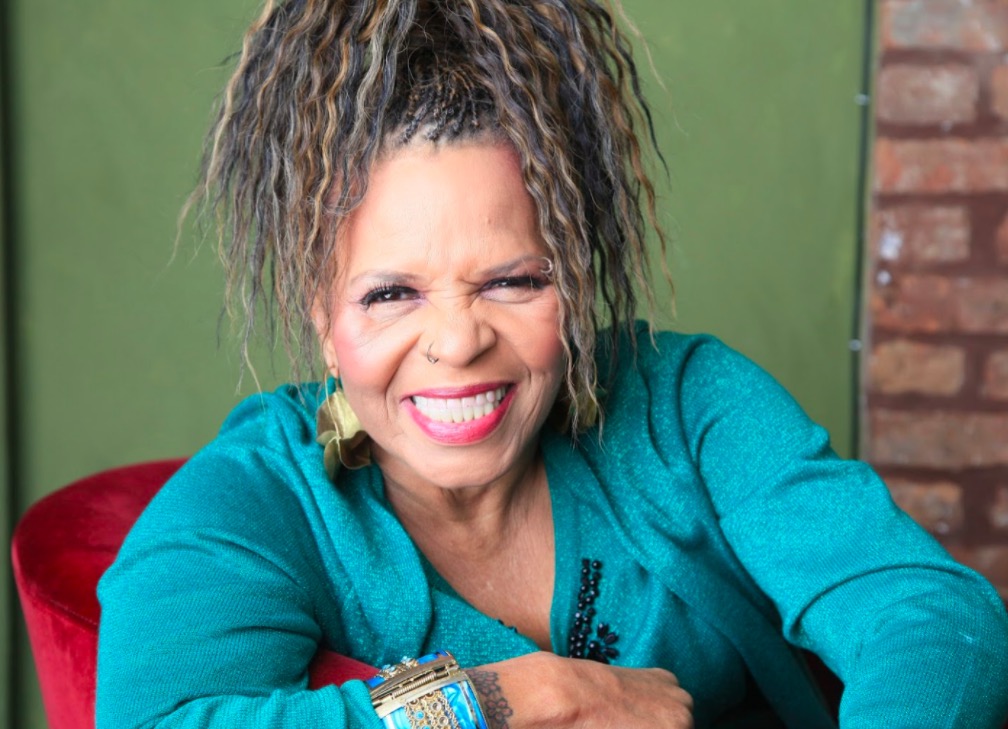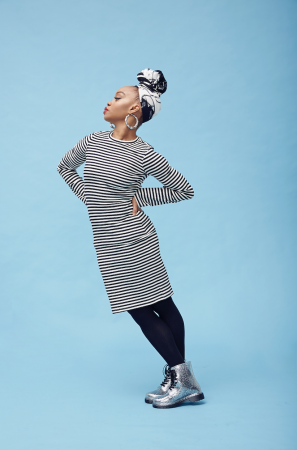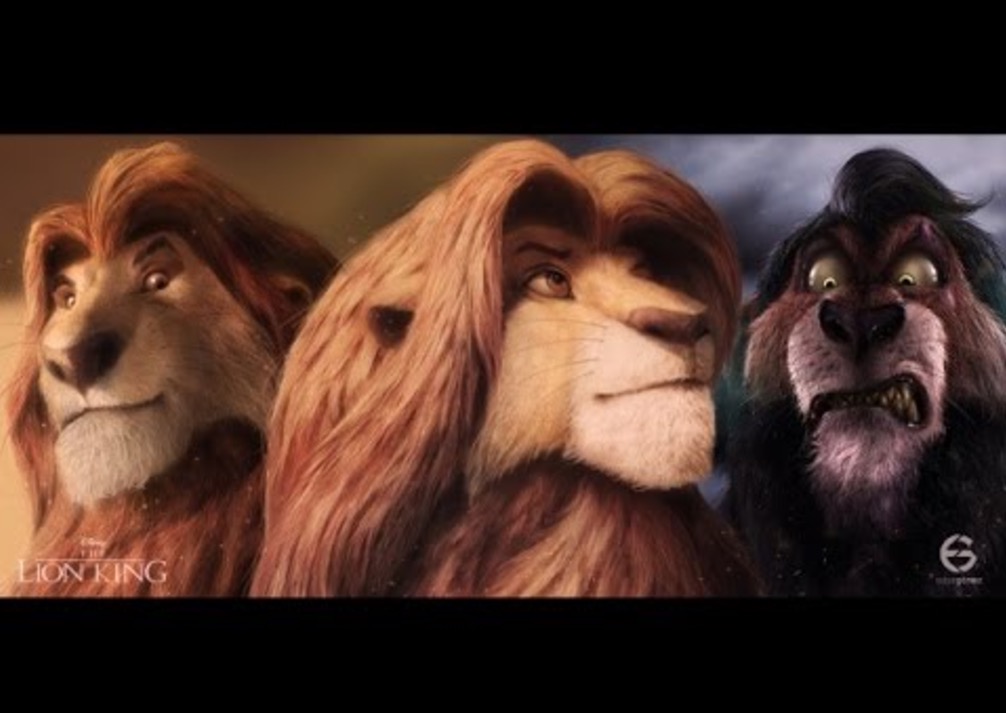

Features
There’s No One Like Ntozake Shange, Wild Beauties
Published
8 years agoon
In this multi-part series, Broadway Black interviews Poet Ntozake Shange.
The Legendary Blue Note Jazz Club located in NYC’s Greenwich Village was buzzing in anticipation of Ntozake Shange’s performance of Wild Beauties. Before the start of the show, I interview Shange’s friends, family, and long time fans, asking them “what they were most looking forward to?”
Although hard to believe, it has been over 40 years since the creation of Shange’s seminal work for colored girls who have considered suicide / when the rainbow is enuf. Blue Note audience member’s stories span decades; set in New York City, The Bay Area and every town or city in between.
They recall the moments they felt visible in her poetry. They blush as they confess they performed in local productions of For colored girls as lady in red, lady in green or other women in the play. They smile reciting lines from sechita, pyramid and “no more love poems #1. #2, #3 & #4.” They are nostalgic as they tell me about seeing Shange’s work on and off Broadway. They compare the play to the 1982 PBS American Playhouse production, to the Tyler Perry Film with strong opinions about each iteration. Each felt ownership and protective of Shange’s work. Each came to see the artist whose work changed their lives.
At the end of their testimony, there is a pause. Their unending love for Shange is coupled with their concerns for her. I disclose I am writing about the performance and as a result, many ask me with caution in their eyes, about her health.
Is she healthy (enough to do this)? Is she too old to do this? Will this be her last performance?
These questions are caring and well meaning yet, problematic; heavily anchored in western cosmologies about health and our fears of a changing body. I graciously shift the conversation, encouraging them to relax and enjoy the show. As a journalist, I understand it is important to address these curiosities as it relates to Shange’s most recent performance and the legacy of her work.
 I had the pleasure to sit with Shange the morning of her Blue Note performance. She candidly discusses her health, her body and her excitement to be performing again since recovering from stroke related medical complications over the last decade. It’s no secret that stroke rehabilitation has been an important part of recovery, as she shared the successes and setbacks on her journey towards wellness. “I went through a period where I didn’t write. I didn’t perform. I concentrated on my physical rehabilitation. I had to learn how to hold things, how to sit up how to stand.”
I had the pleasure to sit with Shange the morning of her Blue Note performance. She candidly discusses her health, her body and her excitement to be performing again since recovering from stroke related medical complications over the last decade. It’s no secret that stroke rehabilitation has been an important part of recovery, as she shared the successes and setbacks on her journey towards wellness. “I went through a period where I didn’t write. I didn’t perform. I concentrated on my physical rehabilitation. I had to learn how to hold things, how to sit up how to stand.”
She is thrilled with the progress she continues to make in rehab. Shange who is a gorgeous 68-year-old woman glows when she talks about dancing. She approaches her physical therapy as if it were a movement workshop often asking her cab drivers to play Latin music and dances in the back seat as she rides.
In our conversation, she strikes me as a fiercely independent woman. She is a Black artist who takes pride in the craft of her poetry. Shange reluctantly depends on speech recognition software to write poetry as the software seeks to not only auto correct but colonize the beauty of black phraseology that is the essence of her work.
Her writing uses a Black talk that dances like jazz telling stories of the diaspora. Her work is the embodiment of Blackness moving in the air to manifest emotion, uniquely her own and there is no one on earth who can replicate. Software certainly can’t do what Shange can do and this is a source of her frustration.
Shange tells me Maya Angelou sent her children’s books to read as she regained her speech. She tells me about times when walking, moving and certainly dancing was impossible. How getting a typewriter helped her feel more connected to her work. She still has poems to write and desires this connection to her words.
She shares that rehearsals are going well and how she loves working with musicians William “Spaceman” Patterson, Michael Raye and Patmore Lewis. She is ecstatic to be back on stage in front of audiences. This is the conversation I am recalling in my mind as audience members whisper to me about her health. This is the reason I decline to speculate, I figure Shange would do what Shange came to do. Perform poems. Dance. Take Names.
The return to the stage at Blue Note feels like a homecoming for Shange. She explains ” I began working in night clubs with musicians reading my poetry. That is how for colored girls started. I feel like it’s the beginning again.”
At the start of the night, the announcer welcomes the audience to Blue Note, painfully mispronouncing her name. The audience rumbled, rolling their eyes in her defense while yelling “Its N-to-ZAH-kee SHAHNG-gay. Her name is N-to-ZAH-kee SHAHNG-ga!” said many voices from neighboring tables.
When the musicians William “Spaceman” Patterson & Michael Raye take the stage the audience tosses their annoyance aside and settles in for the show. Shange soon followed. The audience gives a standing ovation before she utters a word.
She came out swinging. Normally Shange likes to ease audiences into her work offering safety at the start of her sets but she had something to say about PRIDE. Her opening poem, ODE TO ORLANDO is about the Orlando Night Club Tragedy. In June 2016, 49 people were killed and 58 wounded due to hate a crime inside Pulse, a gay nightclub in Orlando, Florida. Shange lyrically takes audiences to the inside of Pulse nightclub where the black and brown queer bodies gather to celebrate Pride month. Her poem collages stories of her daughter who could’ve been there but wasn’t there. This poem is timely and tender, embracing the spirit of Pride season while not forgetting the need for LGBTQ liberation all year around.
She shares a poem titled LOOSENING STRINGS, OR GIVE ME AN “A”. Shange, a self-described Black girl who grew up listening to “white boys who sang weird harmonies that all sound the same” on the radio states “Yes, Eric Clapton made me want to have a child named Layla.” She has a sense of humor. The audience laughs in tune with her confessions.
Shange like a bandleader of a jazz orchestra moves us through experiences that are terrifying and soft. In THERE ARE NO MARKERS, she reminds us of the brutal reality of Blackness in America. She draws the audience into her world with I had five nose rings.
I had five nose rings
a gold circle
a silver circle
a star
nefertiti
& a half moon
without these I am unarmed
not ready for arbitrary violence
There is no question that Shange captivates audiences. Her poetry, her presence her aura is magnetic. We have heard her words in cafes in local theaters, on Broadway and in Hollywood performed by some of the greatest Black actresses of all time, yet there is nothing like hearing Shange perform her own work. She is beautiful and particular. It is this closeness with her, her words, her journey that audiences are still yearning for 40 years after for colored girls took Broadway by storm at the Booth Theatre in NYC.
You may like
1 Comment
Leave a Reply
Cancel reply
This site uses Akismet to reduce spam. Learn how your comment data is processed.
Features
Photo Exclusive: Step into The Light with Broadway Black
Published
7 years agoon
February 21, 2019
Have you seen The Light by Loy A. Webb at MCC Theater? If you haven’t, then you need to and Broadway Black has got you. Join us on SUNDAY MARCH 3rd for the BWAYBLK Experience!
Use code BWAYBLACKMCC and pay $35 for any seat on Mar 3 at the 7:30 performance
Not every marriage proposal goes as planned. LOY A. WEBB’s THE LIGHT introduces us to RASHAD and GENESIS on what should be one of the happiest days of their lives, but their joy quickly unravels when ground-shifting accusations from the past resurface in this gripping two-character drama. Can their relationship survive the growing divide between them over who–and what–to believe?
Also, get into this amazing photo series of playwright Loy A. Webb & the cast of her play The Light. Photos by Curtis Brown were taken in the new elegantly designed and strategically welcoming Robert W. Wilson MCC theater space. Located in midtown New York on 52nd and 10th ave (511 W 52nd ST
New York, NY 10019)
On another tip, some really dope creatives will do a talkback after the Saturday matinee performance that you might be interested in attending. Make sure to RSVP.
Panelists include: Nissy Aya, Cristina Pitter, Alicia Rodis & Kavita Mehra
THIS WEEKEND SAT FEB 23rd
LOY A. WEBB’s THE LIGHT at MCC Theater delves deeply into one couples’ reckoning with an encounter with sexual violence that has left audiences asking: as a partner, a family member, a friend, how do we support sexual assault survivors? And what responsibility do artists have to create work that is trauma-informed? On SAT FEB 23 at 4:00 PM for an in-depth conversation about the power of allyship rooted in love and healing – in our lives and on our stages – in the face of trauma.
SAT FEB 23 at 4PM
THE ROBERT W. WILSON MCC THEATER SPACE
511 W52 ST
RSVP HERE.
Features
A Superhero On & Off The Stage, Camille A. Brown Brings ink
Published
7 years agoon
February 5, 2019

Camille A. Brown Photo by Whitney Browne
Camille A. Brown‘s dance company, Camille A. Brown & Dancers, tours nationally and internationally and will be presenting six performances featuring the debut of ink at The Joyce Theater NYC Feb 5-10th 2019.
Propelled by the live rhythms and sounds of traditional African and handmade instruments, Camille A. Brown’s ink celebrates the rituals, gestures, and traditions of the African diaspora. Highlighting themes of brotherhood, community, and resilience, the work seeks to reclaim African American narratives and is the final installment of Brown’s dance theater trilogy about identity.
In addition to her company works, Ms. Brown brings her passion for storytelling to her award-winning choreography for Broadway, Television, and Off-Broadway. Productions include Tony Award Winning Once On This Island, (Drama Desk, Outer Critics and Chita Rivera award nominations), Emmy Award Winning Jesus Christ Superstar Live on NBC, A Streetcar Named Desire, Choir Boy, the upcoming Magic Mike The Musical, PAL JOEY.
We had the chance to probe a little bit into the world of Camille A. Brown, and we’re grateful for the insight and wisdom with which she was able to bless us. Check out the interview below along with an excerpt from ink.
Broadway Black (BB): After forming the idea, what was the process of building ink?
Camille A. Brown (CAB): After the creative process for BLACK GIRL: Linguistic Play, I held a desire to dig even deeper and tell more stories of ritual, gestural vocabulary, and traditions of the African Diaspora. I was immediately drawn to two albums that had a significant impact on me when I was growing up. The Miseducation of Lauryn Hill by Lauryn Hill, and Like Water for Chocolate by Common. I tasked myself with creating a movement language that embodied the same raw authenticity, and vulnerability that fuels those lyrics and music.
As I began to develop the concept for ink, I wanted the dancers to represent superheroes. I couldn’t figure out why I had the urge to play with this idea until I read Question Bridge: Black Males in America. One of the men interviewed said, “I see Black people as comic book heroes because they always keep rising.” That was it! It is about showing that in our basic survival, and natural attributes we have superhuman powers. Powers to shift, overcome, transform, and persevere even within an often hostile environment. The seven sections of ink represent super powers of spirituality, history and heritage, the celebration of the Black female body, Black love, brotherhood, exhaustion, and community.
The process involves a deep collaboration with the dancers and my direction is guided by their choice making.
The space is very organic and fueled by research. My dancers, musicians, dramaturgs, and I are in constant dialogue throughout the process about the work and how it’s progressing. We don’t move forward unless we’re all on the same page.
We are building the work together. As a disclaimer, I let everyone know the process will be exceptionally tedious. Like a fine comb, I go through each beat, gage the temperature of storylines, and make sure the movement and music are always in conversation (whether aligned or in contrast).
BB: What made you want to start your own dance company and how have you sustained?
CAB: I found my love of choreography in college because I struggled with body image, and found that creating my own voice was a safe and empowering space. After graduating, I danced with Ronald K. Brown/Evidence for 5 seasons and during my second year with The Company, a friend from college (Amy Page) sent me a flyer for the Hubbard Street 2 competition which picks 3 choreographers to create work on the Company. I was chosen! That gave me the encouragement to pursue choreography. My first idea was to take an alias like female writers used to do because even at 22, I knew the playing field was not leveled and women (particularly black women) did not get as much exposure as male choreographers. Dance is revealing and vulnerable so taking an alias wasn’t a realistic option. People would have to see me as I am, but I also needed the confidence to withstand the obstacles. Not only that, having a company seemed daunting.
Ron wore so many hats. He was the director, choreographer, teacher, and also took on administrative duties. He never got a break. I wasn’t confident I could handle all of the duties.
I set work on other companies, but soon realized it wasn’t for me. 1-4 weeks working with a Company wasn’t enough time for me to really hone my skills, find my voice, and discover my personal creative process. I desired a more intimate relationship and space with my dancers and collaborators. I had my first show at Joyce SoHo in 2006, and committed to having a company in 2010.
What sustains CABD is my team. I have a company agent (Pamela Green), Managing Director (Indira Goodwine), Company Manager (Michelle Fletcher), and a production team who holds things down.
In the beginning, I was doing ALL the jobs! As time went on, my team slowly formed. It’s really about patience and perseverance. Nothing happened over night and everything is a progression.
BB: How have you had to be a superhero in your own life personally and professionally?
CAB:
Personally
Last year, I had a life-threatening experience. My appendix ruptured on tour. Appendicitis is when they remove your appendix before it ruptures, but mine actually did and the fluid was in my system for at least a week. I survived the “fatal” stage- which the doctors told me isn’t common. This started a very long year and a half which included 4 hospital stints and two surgeries (my second one was in April). This all happened during Once on This Island (I was in the hospital the first week of rehearsal and had my first surgery during tech), Jesus Christ Superstar Live, and my Company touring. I had to access my “superpowers” and push through, but thankfully I had my team and community to help me.
I’m going to be writing about the entire ordeal because it was such an integral part of my life. People see the “success”, but if they only knew the hardships I had to overcome to get to the other side.
Professionally
Being a Black female Choreographer and Director is hard. People ask me to do I feel like I’ve arrived. Absolutely not. I’m still Black and a woman- two underrepresented groups- particularly in theater. The playing field is still not leveled and I’m clear I have to work twice as hard.
I’ve had to build up strength and confidence. It is an ongoing process of gathering those superpowers. In many spaces, I’m sometimes the only woman (I was the only woman on the creative team for Jesus Christ Superstar Live), and the only black person in some rooms.
Recently two black girls at different events asked me the same exact question: How do you navigate spaces where you’re the only one.
It’s quite easy to feel intimated and shrink yourself. I know I have done that in the past. Now, I’ve found if I think about the black women before me in similar spaces, black women who are currently in similar spaces, and the next generation of black women coming after me, it makes me more confident. When it’s not just about you, it becomes a responsibility.
And even when I don’t feel like I have any superpowers, this happens…
and it refuels and encourages me to keep going. Someone is always watching.













Pingback: Honoring the Life & Work of Dr. Ntozake Shange - Broadway Black